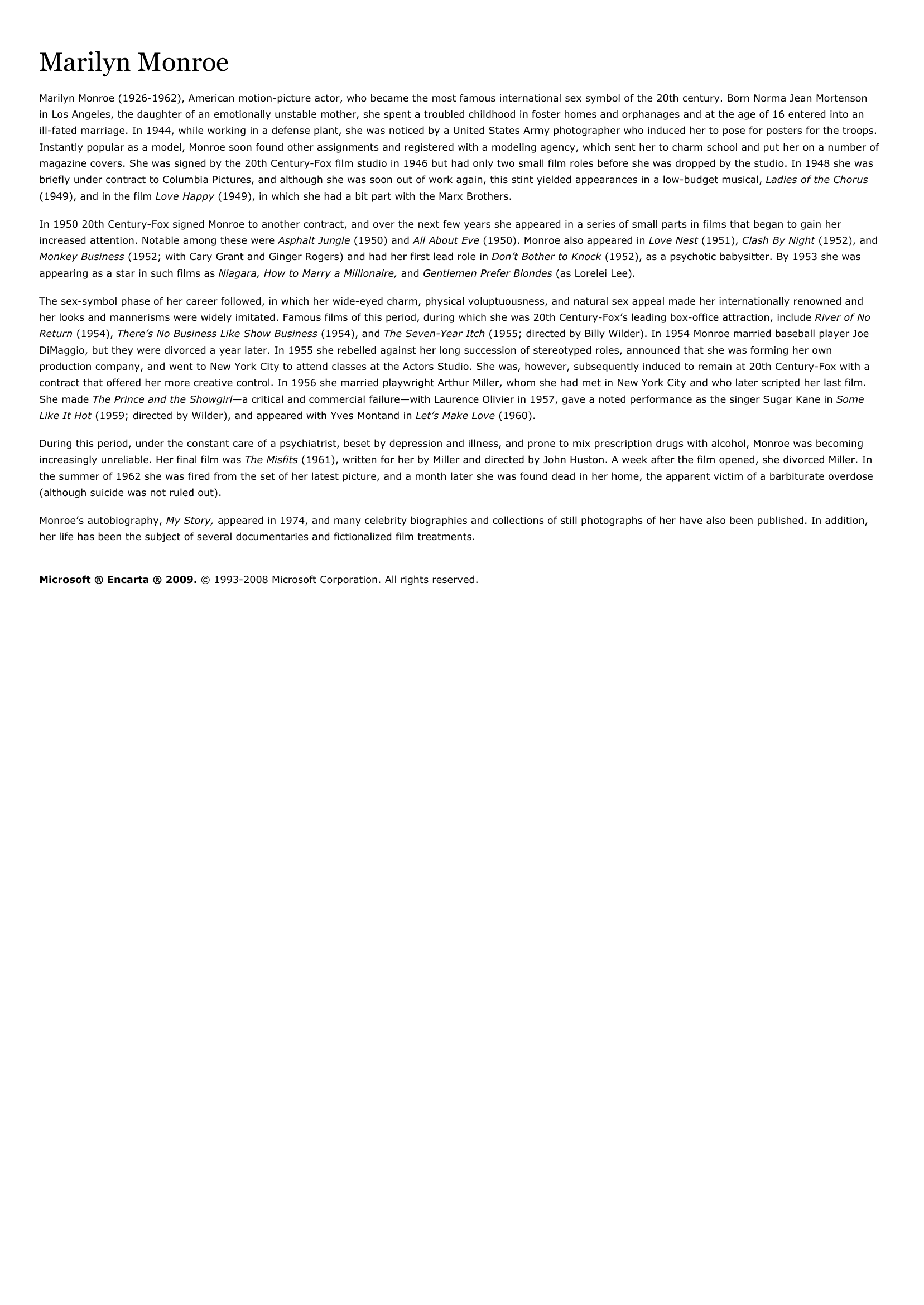Marilyn Monroe: Une tournée en Corée du Sud
Publié le 11/04/2019

Extrait du document
Une tournée en Corée du Sud
En 1953, Marilyn Monroe, alors âgée de vingt-sept ans et sous contrat avec la 20th Century Fox, est au début d'une gloire internationale. C'est en effet cette année-là que sortent sur les écrans du monde entier trois films dans lesquels elle tient le rôle principal: \"Niagara\", \"Les hommes préfèrent les blondes\" et \"Comment épouser un millionnaire\". En février de l'année suivante, alors qu'elle se trouve au Japon en compagnie de son nouveau mari, le joueur de base-ball Joe DiMaggio, elle est contactée par l'état-major des troupes américaines stationnées au Japon, qui lui demande d'effectuer une tournée en Corée du Sud. Séduite par l'idée, elle accepte aussitôt et, du 16 au 20 février, fait la tournée des camps américains en Corée du Sud, se produisant devant plus de 100000 soldats enthousiastes.
«
Powered by TCPDF (www.tcpdf.org)Marilyn Monroe
Marilyn Monroe (1926-1962), American motion-picture actor, who became the most famous international sex symbol of the 20th century.
Born Norma Jean Mortenson in Los Angeles, the daughter of an emotionally unstable mother, she spent a troubled childhood in foster homes and orphanages and at the age of 16 entered into anill-fated marriage.
In 1944, while working in a defense plant, she was noticed by a United States Army photographer who induced her to pose for posters for the troops.Instantly popular as a model, Monroe soon found other assignments and registered with a modeling agency, which sent her to charm school and put her on a number ofmagazine covers.
She was signed by the 20th Century-Fox film studio in 1946 but had only two small film roles before she was dropped by the studio.
In 1948 she wasbriefly under contract to Columbia Pictures, and although she was soon out of work again, this stint yielded appearances in a low-budget musical, Ladies of the Chorus (1949), and in the film Love Happy (1949), in which she had a bit part with the Marx Brothers.
In 1950 20th Century-Fox signed Monroe to another contract, and over the next few years she appeared in a series of small parts in films that began to gain herincreased attention.
Notable among these were Asphalt Jungle (1950) and All About Eve (1950).
Monroe also appeared in Love Nest (1951), Clash By Night (1952), and Monkey Business (1952; with Cary Grant and Ginger Rogers) and had her first lead role in Don’t Bother to Knock (1952), as a psychotic babysitter.
By 1953 she was appearing as a star in such films as Niagara, How to Marry a Millionaire, and Gentlemen Prefer Blondes (as Lorelei Lee).
The sex-symbol phase of her career followed, in which her wide-eyed charm, physical voluptuousness, and natural sex appeal made her internationally renowned andher looks and mannerisms were widely imitated.
Famous films of this period, during which she was 20th Century-Fox’s leading box-office attraction, include River of No Return (1954), There’s No Business Like Show Business (1954), and The Seven-Year Itch (1955; directed by Billy Wilder).
In 1954 Monroe married baseball player Joe DiMaggio, but they were divorced a year later.
In 1955 she rebelled against her long succession of stereotyped roles, announced that she was forming her ownproduction company, and went to New York City to attend classes at the Actors Studio.
She was, however, subsequently induced to remain at 20th Century-Fox with acontract that offered her more creative control.
In 1956 she married playwright Arthur Miller, whom she had met in New York City and who later scripted her last film.She made The Prince and the Showgirl —a critical and commercial failure—with Laurence Olivier in 1957, gave a noted performance as the singer Sugar Kane in Some Like It Hot (1959; directed by Wilder), and appeared with Yves Montand in Let’s Make Love (1960).
During this period, under the constant care of a psychiatrist, beset by depression and illness, and prone to mix prescription drugs with alcohol, Monroe was becomingincreasingly unreliable.
Her final film was The Misfits (1961), written for her by Miller and directed by John Huston.
A week after the film opened, she divorced Miller.
In the summer of 1962 she was fired from the set of her latest picture, and a month later she was found dead in her home, the apparent victim of a barbiturate overdose(although suicide was not ruled out).
Monroe’s autobiography, My Story, appeared in 1974, and many celebrity biographies and collections of still photographs of her have also been published.
In addition, her life has been the subject of several documentaries and fictionalized film treatments.
Microsoft ® Encarta ® 2009. © 1993-2008 Microsoft Corporation.
All rights reserved..
»
↓↓↓ APERÇU DU DOCUMENT ↓↓↓
Liens utiles
- Marilyn Monroe
- Andy Warhol 1928-1987 Marilyn Monroe 1962 - Sérigraphie et acrylique sur toile, 104 x 144 cm Tate Gallery, Londres
- Marilyn Monroe, 1954 [Willem de Kooning] - étude du tableau.
- WARHOL, Andy: Marilyn Monroe
- Marilyn Monroe - KUNSTLER.

































